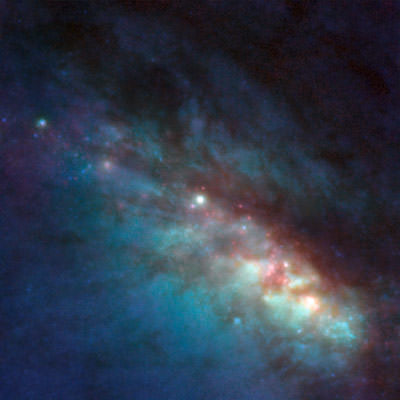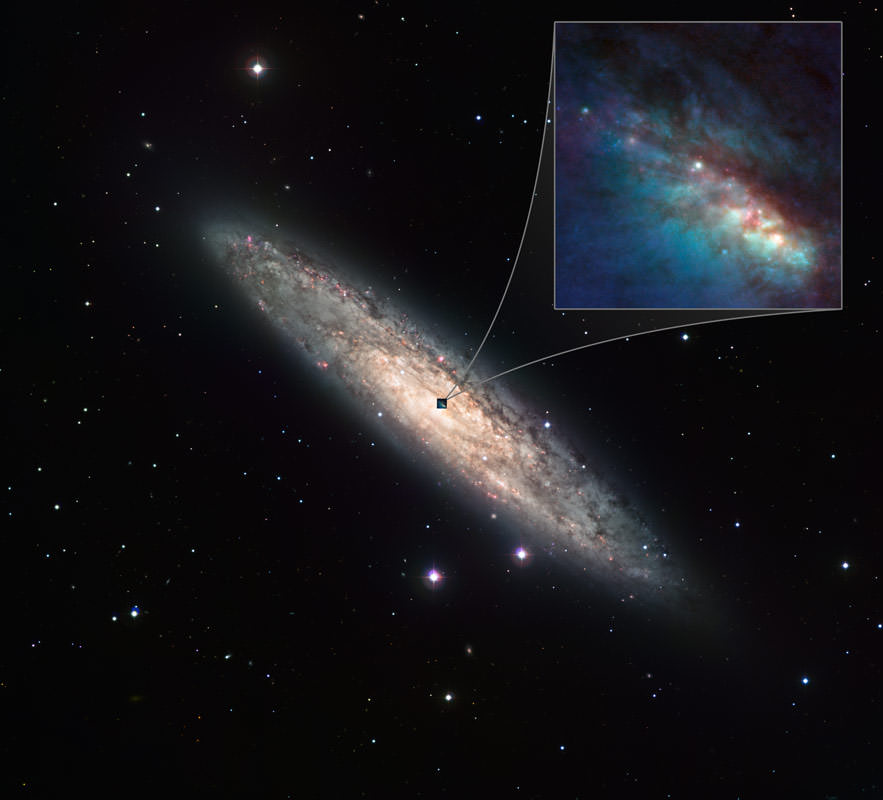[/caption]
Using data from the Very Large Telescope’s powerful near-infrared eyes, astronomers have created a movie that takes you across 13 million light-years to galaxy NGC 253, an active galaxy filled with young, massive and dusty stellar nurseries. “We now think that these are probably very active nurseries that contain many stars bursting from their dusty cocoons,” says Jose Antonio Acosta-Pulido, a member of the team from Instituto de Astrofísica de Canarias in Spain. NGC 253 is known as a starburst galaxy, after its very intense star formation activity. Each bright region could contain as many as one hundred thousand young, massive stars. And in the center of this galaxy appears a strikingly familiar sight: a virtual twin of our own Milky Way’s supermassive black hole.
Watch the movie. (For different viewing options, click here).
The astronomers used NACO, a sharp-eyed adaptive optics instrument on the VLT to study the fine detail in NGC 253, one of the brightest and dustiest spiral galaxies in the sky. Adaptive Optics (AO) corrects for the blurring effect introduced by the Earth’s atmosphere. This turbulence causes the stars to twinkle in a way that delights poets, but frustrates astronomers, since it smears out the images. With AO in action the telescope can produce images that are as sharp as is theoretically possible, as if the telescope were in space.
NACO revealed features in the galaxy that were only 11 light-years across. “Our observations provide us with so much spatially resolved detail that we can, for the first time, compare them with the finest radio maps for this galaxy — maps that have existed for more than a decade,” says Juan Antonio Fernández-Ontiveros, the lead author of the paper reporting the results.

Astronomers identified 37 distinct bright regions packed into a tiny region at the core of the galaxy, comprising just one percent of the galaxy’s total size. This is three times more than seen previously. The astronomers combined their NACO images with data from the infrared instrument on VLT, the VISIR, as well as with images from the NASA/ESA Hubble Space Telescope and radio observations made by the Very Large Array and the Very Large Baseline Interferometer. Combining these observations, taken in different wavelength regimes, provided a clue to the nature of these regions.
In looking at all the data together, astronomers concluded that the center of NGC 253 hosts a scaled-up version of Sagittarius A*, the bright radio source that lies at the core of the Milky Way and which we know harbors a massive black hole. “We have thus discovered what could be a twin of our Galaxy’s Centre,” says co-author Almudena Prieto.
Source: ESO


Sometimes I just wonder: what if an intelligent being was looking towards the Milky Way from there? We’d be 13 million years in the future taking this picture as “it” was taking its picture 13 million years ago. Just imagine that, 13 million years separating us!
Why can’t our species just “grow up” to become an intergalactic progressive (secular humanist) spacefaring species?
This picture needs to be “popularized” across spaceship Earth to all cultures.
Why doesn’t the galaxy get sucked into the alleged “black hole” by the black hole’s alleged gravitational attraction?
“…the ‘Schwarzschild singularities’ do not exist in physical reality.” — Albert Einstein, 1939
The movie is great.
Just how much better are the telescopes going to get? Is there a limit?
Just great.
Damian
OilIsMastery: It’s because of six simple words. Read them carefully: Black holes don’t work that way. It’s for the *same exact reason* that planets don’t fall into stars, and moons don’t fall into planets (if they’re in a stable orbit, at least).
Please learn your gravity.
Closest I’ll ever get to having my own FTL drives. Fantastic.
So black holes don’t work and gravity doesn’t effect the orbits of planets. I follow you now.
Oils, I suspect you do not really know what a black hole is. It does not necessarily has to be a singularity. You may want to check out the definition in Wiki: http://en.wikipedia.org/wiki/Black_hole It begins with a definition of a black hole by Einstein, who you apparently respect (assuming from your quote). And btw, what exactly is wrong with stars and other material orbiting a black hole? I do not see any conflict there, and no reason why the gravity or the black hole would not work as expected. You could also tell that the gravity of the Sun does not work, because the Earth does not fall into it. I suppose you realize it is false (in both cases).
OillsMastery: where in “six simple words. Read them carefully” did you go wrong?
And OillsMaster, respective the quote: “…the ‘Schwarzschild singularities’ do not exist in physical reality.” [Albert Einstein, 1939]
Apparently you completely misinterpreted the idea. It does not tell black holes do not exist. It only tells that the singularity is a theoretical interpolation which does not physically exists, but is used as analogy for the mathematic model, because we simply have no chance to observe anything beyond the event horizon, so will probably never know how the matter is organized inside it. In no way it ought to mean black holes do not exist. That’s just your own extrapolation.
FYI, Oil was recently banned from BadAstronomy for his insipid trolling. Looks like he’s trying to add another site to his list.
NGC 253 in Sculptor is on the Herschel 400 list and is one of its finest objects, easily visible in binoculars or telescopes.
It’s a bit more comfortable viewing on the internet, however, especially when the temps are going to fall below zero in Minny tonight.
trux is right. Most galaxies revolve around super-massive blackholes and the one we live in looks pretty stable.
Trux,
The scientific method requires observation and experiment. Since black holes cannot be observed or experimented upon, people who believe in black holes and invisible pink unicorns are blatantly engaging in theology or worse.
OK, so according to you the stars orbitting a black hole we can observe, are not bound gravitationally to the black hole, but are tight to the center with some giant rubber bungees? And the matter we can observe sinking into the black holes are in fact destroyed by a giant cosmic troll? Well, if you want call it that way, why not, but the more common name for the gravitational binding and the sinkhole is simly …. a Black Hole.
If you deny black holes, you necessarily have to deny also graviational lensing (which we can observer very well). If a massive object can bend light, how can you deny that a suffciently massive object can trap the light? Give me a single reason for that, and I will join you in the Don Quichotian war against black holes.
Trux,
No. According to me black holes and gravity do not exist.
No one has ever observed matter sinking into a black hole.
And yes I also deny gravitational lensing. Since photons are alleged to be massless particles it is impossible for the alleged force of gravity to act on them.
sb,
I was banned from Bad Astronomy because Phil Plait is afraid of words and afraid to debate.
Oills, please explain what the lensing effect we can oberve is, if it is not gravitational lensing. And please explain us also why stars orbit around something we call Black Holes, if there is no gravitation involved.
Trux,
The lensing effect a myth.
When you observe 2 stars next to eachother or 4 stars in a cross shape you assume it’s a gravitational lens or Einstein Cross but only when it suits you.
For example, are the two quasars 15 arc minutes apart with the Arp 220 galaxy in between a gravitational lens?
Orbits are caused by electromagnetic force and not gravity. Gravity predicted that the stars orbiting Sagittarius A* would fall into the alleged black hole candidate by it’s overwhelming gravitational force and not orbit it regularly.
Why is the gravitational lensing transitional and exactly matching the mathematical model behind it? If they were just random stars, would’n they last longer in their trajectories than stars only temporarily visible through the transiltional lensing?
Can you please show us the source for your claim that the orbit and speed of stars orbiting Sagitarius A* do not match with its gravity? I only saw studies showing the oposite.
extinctionshift dot com slash SignificantFindings dot htm
“Since photons are alleged to be massless particles it is impossible for the alleged force of gravity to act on them”
I think we need to come out of Newtonian Physics of Gravitation. Gravity is more fundamental.The Time-Space warping that happens because of a body’s own heavy mass pulls even light towards it.Photons need not have mass to fall prey to Gravity.
Oills, I admit that the article you posted, with the formulas and pictures may be impressive for someone who has only limited knowledge. However it contains some flaws and misinterpretations (for example it ignores that the background object needs to be in a suffcient distance, while being still strong enough to be detected). Experts studying microlensing do not seem to agree with the conslusions from the article. The principal piece of evidence used in the article against gravitational microlensing is the NGC 3314 galaxy. But if you look up detailed information about it on the Internet, you will find that in contrary what is claimed in the article, the observed microlensing in NGC 3314 is pretty well such as expected by the theoretical model.
Oills, personally I love diverse alternative theories, and think that non-coventional and sceptic thinking is very much needed in the science. When nothing else, just because even the least probably alternatives need to be explored and excluded. But you make the alternative theories big disservice with your agressive, and often impolite bullying.
Raman,
How can Newton’s theory of gravity be more fundamental than Newton’s physics of gravitation? What’s the difference?
Time and space are not physical material objects so any warping that occurs is only in your mathematical imagination.
Gravity is alleged to act on mass. Since photons are alleged to have no mass, gravity cannot act on it.
Trux, you are ignoring every other astronomical system and body in the universe where no lensing is observed, e.g. the Sombrero Galaxy.
How is presenting an opposing viewpoint being an impolite bully?